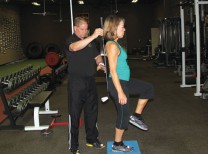Exercise is the single most important factor in maintaining healthy balance and preventing falls. In fact, exercise can also eliminate some types of chronic dizziness! The key is in knowing what kind of exercises to do.
Not all exercises are equally beneficial. Many people mistakenly believe that walking is the best form of exercise. Not so! Although walking is important for general mobility, and provides cardiovascular and joint health benefits, it also has limitations. A recent study looked at seniors who walked in the mall for exercise. The group used walking as their only source of exercise and averaged 1-2 miles a day for 4 days a week. Results? This group had the same amount of falls as sedentary seniors. What went wrong? Actually, nothing. These seniors did enjoy health benefits from their walking such as lowered blood pressure, improved cardiac and lung function, and less arthritic pain. Yet when their balance was tested, there was no improvement in balance control that is important for fall avoidance. The message: improving one’s balance requires specific exercises.
What are the best exercises for balance?
- Tai chi
- Dancing
- Bicycling
- Group exercise classes
- Free weight training (standing up)
These exercises share a theme: dynamic, challenging positions while engaging balance sensory control systems. Interestingly, group exercise programs vary widely but the benefits are insurmountable. They incorporate a large variety of both upper and lower body exercise as well as balance, flexibility, cardiovascular, and strength.
Exercises “not so good” for balance
- Walking on flat surfaces
- Pool exercises
- Universal weight machines
Medical intervention
The Department of Health & Human Services issued a mandate, “The Elder Fall Prevention Act”, which calls for health care providers to identify patients at risk of falling, and implement evidence-based intervention programs. Physical Therapy is prescribed by the physician and rendered by a licensed therapist who specializes in balance disorders. Balance rehab must be dynamic and challenging. Examples of ineffective therapy include: stationary biking and standing on foam with eyes closed. Proper balance rehabilitation involves specific progressive exercises, tailored to a patient’s needs and generally lasting 4-12 weeks. The patients report significant improvements in their balance, leading to improved self-confidence, which contributes to their overall well-being. Once the target balance goals are met, the patient is referred to a fitness trainer to maintain and build on these balance skills. And maintenance is the key!
Dr. Kato is the founder of The Ear Institute in Palm Desert. Her top priority is improving the quality of life of her patients. Dr. Kato can be reached at: 760-565-3900.
Sources: Williams M, Gentili A, Assessment of the Geriatric Patient: Gait and Balance CME/CE: Medscape.com. Oct 28, 2005.; Sherrington C, et al. Effective exercise for the prevention of falls: J Am Geriatr Soc. 2008 Dec;56(12):2234-43.











































Comments (0)